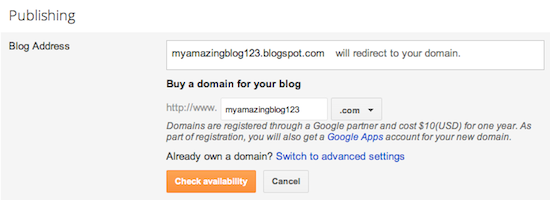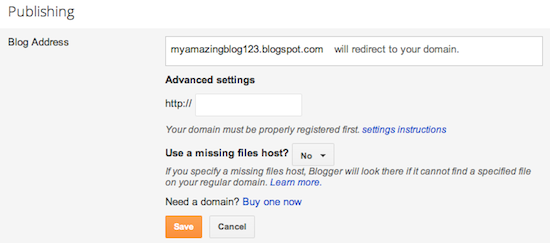How do I create a CNAME record for my custom domain?
The Quick Answer
- If you bought your domain name from Blogger, you won't need to create a CNAME record.
- If your domain is registered with another company, you'll need to follow company-specific instructions.
CNAME
A CNAME, or Canonical Name, record is an entry within the Domain Name System (DNS) that specifies where a user can find your web pages, or any other URL. You'll use the CNAME to associate your custom domain with your blog.After registering your domain, decide if you want to use a particular subdomain for your blog. E.g. instead of
www.mydomain.com you could use something like blog.mydomain.com, if you want. Then you'll create a corresponding CNAME record for that address, associating it with ghs.google.com. Keep in mind that changes to DNS records make take up to 48 hours to take effect.Each hosting service has slightly different ways to create CNAME records. Guidelines are provided here for some of the common services. When in doubt, check with the particular company you're using for additional help or instructions.
- GoDaddy.com
- ix web hosting
- 1and1
- EveryDNS.net
- Yahoo!SmallBusiness
- No-IP
- DNS Park
- Other hosting services
GoDaddy.com
- Log in to your account at www.godaddy.com.
- Open the Domains tab and select My Domain Names. You'll be directed to the Domain Manager page.
- Click the domain that you'd like to use with your blog.
- Click the Total DNS Control And MX Records link at the bottom of the section entitled Total DNS.
- Click Add New CNAME Record in the box labelled CNAMES (aliases). If you've already created a CNAME record for your blog's address, click the pencil icon next to the existing CNAME record.
- For the Name, enter only the subdomain of the address you want to use for your blog. For example, if you picked
www.mydomain.comas your address, enterwwwhere. - Enter
ghs.google.comas the Host Name. Specify a TTL or use the default setting of 1 hour. - Click OK, and then click OK again.
ix web hosting
- Log in to your account at ix web hosting.
- Click Manage below the Hosting Account section.
- On the left side, click the domain you'd like to use with your blog.
- Next to DNS Configuration, click EDIT.
- Click Add DNS CNAME Record.
- Under Name, enter only the subdomain you want to use. For example, if you picked
www.mydomain.comas your blog's address, just enterwwwas the entry under Name. - Enter
ghs.google.comunder Data. - Click Submit.
1and1
- Log in to your account at https://admin.1and1.com
- If it's not already selected, click the Administration tab.
- Click Domains. The Domain Overview page appears.
- From the New drop-down menu, select Create Subdomain. (If you've already created a subdomain for your blog's address, skip to step six.)
- Enter only the subdomain you want to use, and click OK. For example, if you chose
www.mydomain.comfor your blog's address, you should enterwwwhere. - Select the checkbox next to the subdomain that you will be using. (Example:
www.mydomain.com) - From the DNS menu, select Edit DNS Settings.
- Click the radio button next to CNAME.
- Enter
ghs.google.comnext to Alias. - Click OK.
EveryDNS.net
- Log in to your account at EveryDNS.net.
- On the left side, click the domain you'd like to use with your blog.
- Since EveryDNS.net is your hosting service, and not your domain registrar, be sure that your domain points to EveryDNS.net's nameservers. This will allow your CNAME record configuration to take effect.
- Below Add a Record:, you can create your CNAME record.
- Next to Fully Qualified Domain Name, enter only the subdomain you want to use. For example, if you picked
www.mydomain.comas your blog's address, just enterwwwas the entry next toFully Qualified Domain Name. - Select CNAME as the Record Type.
- Enter
ghs.google.comas the Record Value. - Click Add Record.
Yahoo!SmallBusiness
- Log in to your account at smallbusiness.yahoo.com.
- Click Domain Control Panel below the domain you'd like to use with your blog.
- Click Manage Advanced DNS Settings.
- Click Add Record.
- In the Source field, enter only the subdomain you want to use. For example, if you designated
www.mydomain.comas the address of your blog, enterwwwin the Source field. - Enter
ghs.google.comin the Destination field. - Click Submit.
No-IP
- Log in to your account at No-IP.
- On the left side, click Host/Redirects.
- Click Manage underneath Host/Redirects.
- Click Add for a new entry, or click Modify and skip to step six for an existing entry.
- Enter the host name (example:
wwwfromwww.mydomain.com), and select your domain name. - Select DNS alias CNAME at the host type.
- Enter
ghs.google.comas the Target Host and click Modify.
DNS Park
- Log in to your account at DNS Park.
- On the left side, click DNS Hosting.
- Click the domain you'd like to use with your blog.
- Since DNS Park is your hosting service, and not your domain registrar, be sure that your domain points to DNS Park's nameservers. This will allow your MX record configuration to take effect.
- Click Alias Records.
- Under Host Name, enter only the subdomain you want to use. If you picked
www.mydomain.comas your blog's address, enterwww. - Under Destination Name, enter
ghs.google.com. - Click Add Alias.
Other hosting services
- Log in to your account on your hosting service's website, and go to the DNS management page.
Since CNAME records are special Domain Name Service (DNS) records, they may be in sections such as DNS Management or Name Server Management. It's possible that you will have to enable advanced settings to create a CNAME record. - Delete existing CNAME entries for the address you want to use with your blog.
Before entering a new CNAME record to point to Google, you should first delete any existing entries for the same alias. If you plan to transfer an existing web address to Blogger, you may want to copy any content currently at that address elsewhere first. - Use the information in the following table when you create your CNAME record.
If your service requires you to enter server information directly into the DNS tables, the entry below needs to have a type CNAME associated with them.
Host Name/Alias Value/Destination www ghs.google.com * This is the part of your website's address that you designated. For instance, if you chose www.mydomain.comas the address,wwwis the host name.
http://support.google.com/blogger/bin/answer.py?hl=en&answer=58317
How do I use a custom domain name for my blog?
Blogger offers two free publishing options for your blog: hosting on Blogspot (example.blogspot.com) and hosting on your own custom domain (www.example.com or foo.example.com). You can change your publishing option at anytime, and your content will always remain unaltered regardless of which of these options you choose.
Whether you want to purchase a new domain through Blogger or publish on a domain which you already own, we’ll walk you through the process of setting up your blog for a custom domain.
Whether you want to purchase a new domain through Blogger or publish on a domain which you already own, we’ll walk you through the process of setting up your blog for a custom domain.
What would you like to do?
Is your URL hosted by GoDaddy.com?
Where would you like to host your blog?
- Find the control panel on your domain registrar’s website, and locate your DNS (Domain Name System) settings. In order to link your blog to your custom domain, follow the instructions below to enter your "CNAME" and "A-records."
CNAME
Where it says Name, simply enter "www" and list ghs.google.com as the Host Name. See our detailed instructions on providing CNAMEs for various registrars. If yours isn't listed, or if you run into other difficulties, contact your registrar directly and they can help you out.
A-records (optional)
The following action links your naked domain (example.com) to your actual site (www.example.com). If you skip this step, visitors who leave off the "www" will see an error page.
Enter your domain name in the format example.com, and list the I.P. addresses shown below in the "A" section. You'll need to create four separate A-records which point to four different Google IPs.
216.239.32.21
216.239.34.21
216.239.36.21
216.239.38.21 - Update your Blogger settings
Before you move onto this step, wait about an hour for your DNS settings to activate. If you attempt to change the publishing settings before the DNS changes activate, then we'll let you know with a warning message.
Now it’s time to make sure Blogger knows about your custom domain so that Google can direct readers to your blog. Just head back to Blogger and update the information on your Settings | Basic tab. Find the area for "Publishing," and click the link to add a custom domain.



- If your new domain isn't taking you to your blog, wait another day or two to make sure all the DNS servers have been updated. If it still isn't working, contact your registrar to make sure you entered the DNS settings correctly.
- Your original Blogspot address will automatically forward to your new domain. That way, any existing links or bookmarks to your site will still work.
- Your posted images will continue to display on your blog.



No comments:
Post a Comment